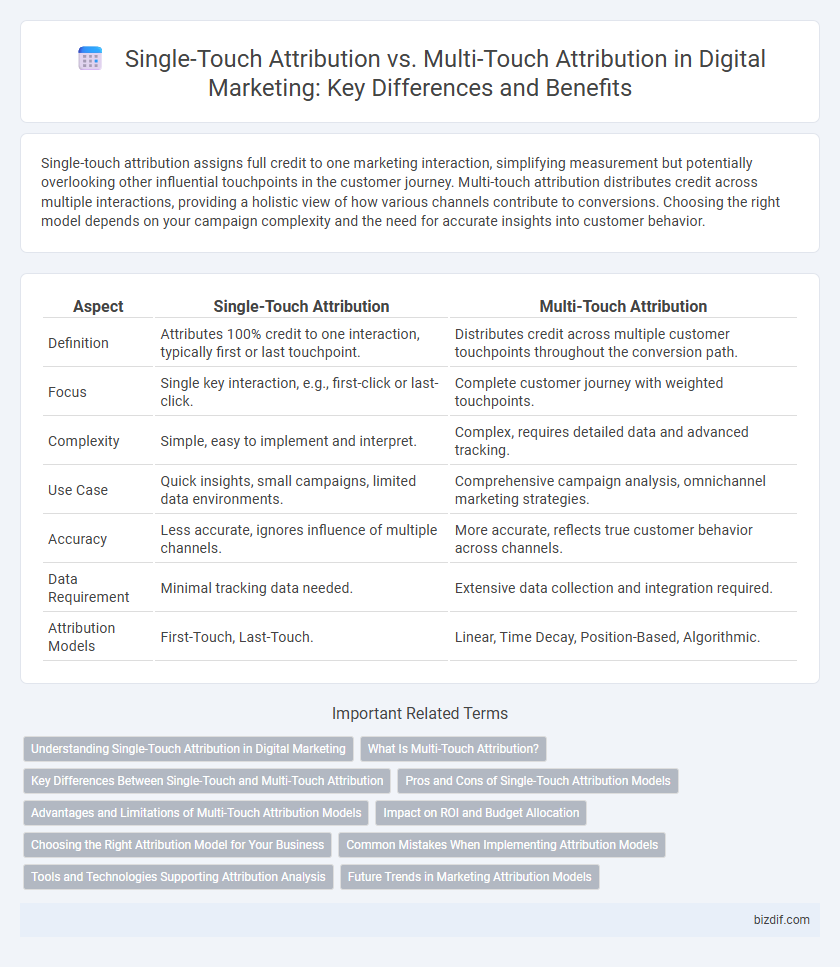Single-touch attribution assigns full credit to one marketing interaction, simplifying measurement but potentially overlooking other influential touchpoints in the customer journey. Multi-touch attribution distributes credit across multiple interactions, providing a holistic view of how various channels contribute to conversions. Choosing the right model depends on your campaign complexity and the need for accurate insights into customer behavior.
Table of Comparison
| Aspect | Single-Touch Attribution | Multi-Touch Attribution |
|---|---|---|
| Definition | Attributes 100% credit to one interaction, typically first or last touchpoint. | Distributes credit across multiple customer touchpoints throughout the conversion path. |
| Focus | Single key interaction, e.g., first-click or last-click. | Complete customer journey with weighted touchpoints. |
| Complexity | Simple, easy to implement and interpret. | Complex, requires detailed data and advanced tracking. |
| Use Case | Quick insights, small campaigns, limited data environments. | Comprehensive campaign analysis, omnichannel marketing strategies. |
| Accuracy | Less accurate, ignores influence of multiple channels. | More accurate, reflects true customer behavior across channels. |
| Data Requirement | Minimal tracking data needed. | Extensive data collection and integration required. |
| Attribution Models | First-Touch, Last-Touch. | Linear, Time Decay, Position-Based, Algorithmic. |
Understanding Single-Touch Attribution in Digital Marketing
Single-touch attribution assigns 100% of the credit for a conversion to one touchpoint, typically the first or last interaction, providing clear insights into which channel initially engaged or closed the customer. This model simplifies analysis but may overlook the influence of multiple marketing efforts across the customer journey. Digital marketers use single-touch attribution to quickly evaluate the effectiveness of specific campaigns, such as email marketing or paid search, driving faster optimization decisions.
What Is Multi-Touch Attribution?
Multi-touch attribution assigns value to every interaction a customer has with a brand before completing a conversion, providing a comprehensive view of the buyer's journey. It tracks multiple touchpoints such as social media clicks, email opens, and paid search ads, enabling marketers to understand how each channel contributes to the final sale. This method offers granular insights that help optimize marketing strategies by accurately distributing credit across various consumer engagements.
Key Differences Between Single-Touch and Multi-Touch Attribution
Single-touch attribution assigns credit to a single marketing interaction, typically the first or last touchpoint, simplifying the analysis but potentially overlooking the full customer journey. Multi-touch attribution distributes credit across multiple touchpoints, providing a comprehensive view of how various channels like email, social media, and paid search contribute to conversions. This approach offers deeper insights into marketing effectiveness and helps optimize budget allocation across campaigns.
Pros and Cons of Single-Touch Attribution Models
Single-touch attribution models allocate 100% of the credit to a single interaction, simplifying the analysis and providing clear insight into the most influential touchpoint in the customer journey. However, these models overlook the complexity of multi-channel marketing efforts and can misattribute conversions, leading to skewed ROI measurements and suboptimal budget allocation. Businesses relying solely on single-touch models risk undervaluing key touchpoints that contribute to conversion over time.
Advantages and Limitations of Multi-Touch Attribution Models
Multi-touch attribution models provide a comprehensive view by assigning credit to multiple marketing touchpoints, enhancing the accuracy of campaign performance analysis. These models improve budget allocation by identifying the most effective channels and customer interactions throughout the sales funnel. However, multi-touch attribution requires complex data integration and advanced analytics, which can lead to increased implementation costs and challenges in attributing credit precisely across diverse platforms.
Impact on ROI and Budget Allocation
Single-touch attribution assigns all credit to a single marketing touchpoint, simplifying ROI calculation but often misrepresenting campaign effectiveness and skewing budget allocation toward the last or first interaction. Multi-touch attribution provides a comprehensive analysis by distributing credit across multiple touchpoints, enabling more accurate ROI assessment and informed budget decisions that optimize marketing spend. Leveraging multi-touch attribution models enhances strategic investment, ensuring resources are allocated to channels that genuinely drive conversions and maximize overall return on marketing investment.
Choosing the Right Attribution Model for Your Business
Single-touch attribution assigns all credit to one interaction point, ideal for businesses with straightforward sales funnels and limited customer touchpoints; multi-touch attribution distributes credit across multiple interactions, better reflecting the complexity of customer journeys in omnichannel marketing environments. Evaluating your business's marketing channels, customer pathways, and campaign goals helps determine the most effective attribution model to optimize budget allocation and improve ROI. Tools like Google Analytics and attribution platforms enable data-driven decisions by analyzing conversion paths and identifying high-impact touchpoints.
Common Mistakes When Implementing Attribution Models
Common mistakes when implementing attribution models in digital marketing include relying solely on single-touch attribution, which oversimplifies the customer journey by crediting only the first or last interaction, leading to inaccurate ROI analysis. Neglecting to properly integrate multi-touch attribution often results in fragmented data and undervalued touchpoints, causing suboptimal budget allocation. Failing to continuously update and validate attribution models with evolving consumer behavior and cross-channel data limits the effectiveness of marketing strategies.
Tools and Technologies Supporting Attribution Analysis
Single-touch attribution tools like Google Analytics and Adobe Analytics offer straightforward insights by crediting a single interaction, simplifying campaign performance tracking for specific touchpoints. Multi-touch attribution platforms such as HubSpot, Bizible, and Attribution use advanced machine learning algorithms and data integration techniques to analyze multiple customer interactions across channels, providing a holistic view of marketing effectiveness. Technologies like AI-driven analytics, customer data platforms (CDPs), and cross-device tracking enhance multi-touch attribution by aggregating diverse data sources and delivering granular insights into the entire customer journey.
Future Trends in Marketing Attribution Models
Future trends in marketing attribution models emphasize the increasing adoption of multi-touch attribution to capture comprehensive consumer journeys across diverse digital channels. Advances in artificial intelligence and machine learning enable more accurate, real-time attribution by analyzing complex data from multiple interaction points. Single-touch attribution models are expected to decline as marketers prioritize granular insights to optimize budget allocation and improve campaign ROI effectively.
Single-touch attribution vs Multi-touch attribution Infographic

 bizdif.com
bizdif.com